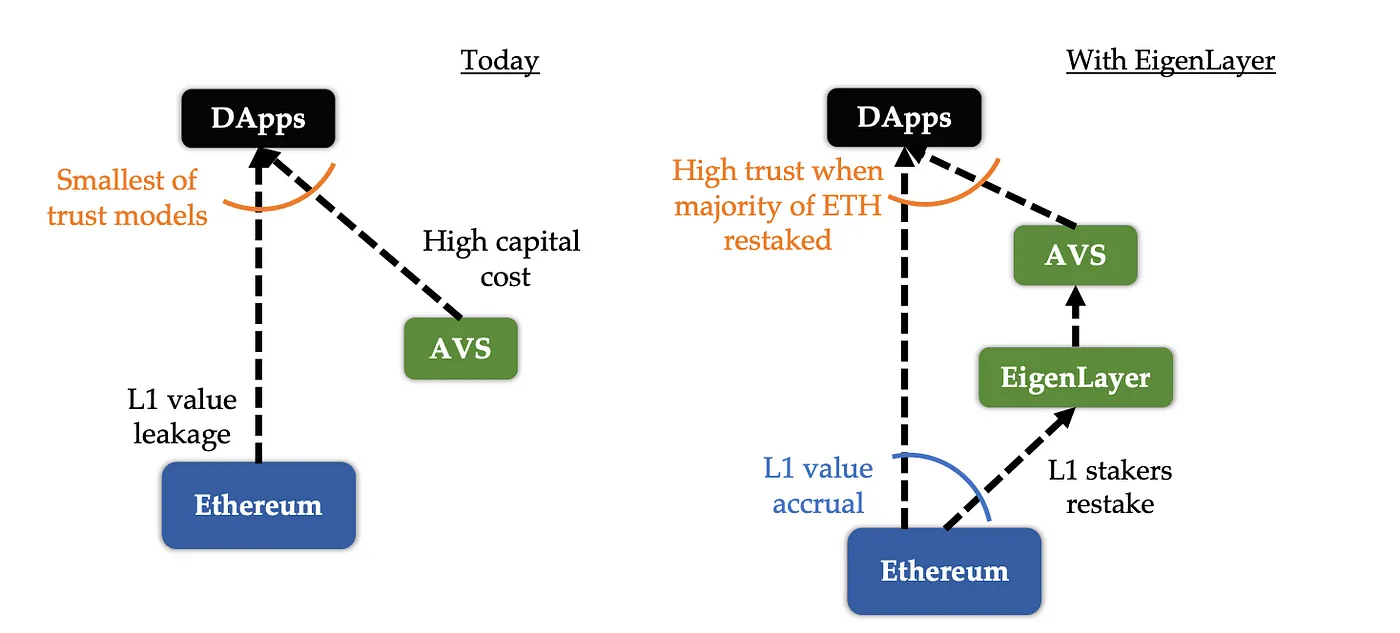We are thrilled to announce our active participation within the EigenLayer ecosystem as a Node Operator. Having worked extensively on the testnet, we’ve now transitioned to the mainnet, marking a significant milestone. In this article, we’ll explore the contributions of EigenLayer, our role as operators, and Restaking.
EigenLayer innovatively introduces ‘Restaking’ — a new paradigm that enhances the capital efficiency and security of ETH. This mechanism allows staked $ETH, initially used for securing Ethereum, to also boost other networks. Moreover, it affords Ethereum stakers an additional yield over their existing $ETH staking rewards, elevating ETH’s utility and security to unprecedented levels.
Understanding the foundation of this innovation is crucial, particularly as Ethereum faces challenges like scalability and security model limitations. These challenges result in various teams developing their own Layer 1 solutions, recklessly creating fragmentation and increasing susceptibility to attacks. EigenLayer’s restaking solution addresses these issues through pooled security and free-market governance, extending Ethereum’s foundational security to virtually any protocol, regardless of its structure.
What’s Restaking?
It’s a new primitive, a pioneering approach where staked $ETH is repurposed to secure multiple networks. This is facilitated through two strategies: Pooled Security and Free Market Governance. Within this marketplace, protocols can procure pooled security from validators, who, in turn, assess risk and reward to determine what AVS they’ll choose to allocate their stake. This market-driven security model enhances the robustness of the entire ecosystem.

EigenLayer’s part
EigenLayer’s role is key to enable Ethereum stakers to concurrently secure multiple services through restaking, significantly amplifying the security and trust across services. This innovative approach leverages Ethereum’s cryptoeconomic security to foster permissionless innovation and governance.
The architectural framework of EigenLayer circles around a variety of key stakeholders:

-
EigenLayer Governance: Operates through a reputation-based committee.
-
AVS Consumers: Utilize the staked or native ETH.
-
Operators: Provide the necessary infrastructure.
-
AVS Developers: Develop the Active Validation Services (AVS) atop the Ethereum network.
As operators, we are integral to this framework, facilitating the delegation of staked assets and complement the service range for AVSs. Our role does not necessitate a predefined amount of restaked TVL, making participation accessible to more Ethereum addresses, which can function as both Restakers and Operators.
Moreover, the introduction of standardized node classes by EigenLayer aims to streamline operations for node operators, optimizing resource allocation and procuring service quality across the ecosystem.
Actively Validated Services (AVSs) play a crucial role, surrounding systems that require distributed validation semantics. Each AVS maintains its relevant state and operational details through designated contracts, integral to the functionality of services ranging from sidechains to oracle networks.
SenseiNode’s role
As SenseiNode, our involvement in EigenLayer’s mainnet as a Node Operator enables us to support diverse AVSs, such as EigenDA — an EigenLabs-developed data availability store. Our commitment to this role stems from our belief in EigenLayer’s potential to significantly advance Ethereum’s ecosystem.
EigenLayer is a game changer that enables service providers to become decentralized and secured by the robust Ethereum Staker Network. Developers building side-chains, oracles, virtual machines, or dapps that require high throughput can now do so by becoming Actively Validated Services (AVS) and connect to a large and secure ecosystem operated by hundreds of Node Operators across the globe. Jesus Chitty — SenseiNode CTO
We are excited to see where EigenLayer goes and to be part of their development!
Conclusion
In conclusion, EigenLayer is a transformative force, decentralizing and securing service providers through Ethereum’s robust network. This initiative not only enhances service security but also catalyzes the growth of Ethereum’s infrastructure, promising an exciting future for developers and operators alike.
For those inspired by this vision and eager to contribute, consider delegating your stake through our Operator:** EigenLayer Operator Link**.
Restaking offers substantial benefits to protocols by reducing the need to establish independent security networks, and to validators by providing additional revenue opportunities, ultimately reinforcing Ethereum’s unified security model. However, participants must be cognizant of risks such as smart contract vulnerabilities and the potential for malicious activities within the network.
This exploration into EigenLayer’s impact underscores the key role we play and the broader implications for the Ethereum ecosystem, setting the stage for further innovation and collaboration.
Ps — Tutorial to delegate your stake
About SenseiNode
SenseiNode is the first blockchain infrastructure independent service provider in Latin America.
We automate and simplify the deployment and monitoring of nodes on leading protocols, providing access via our APIs to organizations looking to build their blockchain infrastructure with a high availability and low total cost of ownership.
Contact us here:
Website — Telegram — Twitter — Linkedin — Instagram — Youtube — Mirror